Mastering Multichannel Inventory Management

Multichannel inventory management is the process of efficiently managing inventory across multiple sales channels. It involves tracking and controlling stock levels to ensure seamless order fulfillment.
For businesses selling through various online platforms, effective multichannel inventory management is crucial. By streamlining operations and improving customer satisfaction, it enables retailers to stay competitive in a rapidly evolving market.
Managing inventory across different channels can be complex, with each platform having its own set of requirements and challenges. However, with the right inventory management system in place, businesses can maintain optimal inventory levels, reduce stockouts, and avoid overstocking.
This allows for efficient order management and fulfillment across multiple locations and marketplaces.
We will discuss key strategies for maintaining accurate inventory levels, optimizing order fulfillment processes, and maximizing sales potential across various sales channels.
On this page:
- Benefits of Multichannel Inventory Management
- Effective Strategies for Multichannel Inventory Management
- Top Software and Tools for Multichannel Inventory Management
- Real-time Visibility and Synchronization
- Customer-Centric Approach and Improved Customer Service
- Warehouse Management Capability and Challenges
- The Importance of Multichannel Inventory Management
Benefits of Multichannel Inventory Management
Managing inventory across multiple channels can provide several advantages for businesses. Let’s explore the benefits in detail:
Reach a Wider Audience
Multichannel inventory management allows businesses to expand their reach by selling on various platforms simultaneously. By diversifying their sales channels, companies can tap into different customer segments and target a larger audience.
For example, a retailer selling products both online and in physical stores can attract customers who prefer the convenience of online shopping as well as those who enjoy the in-person experience.
Avoid Overselling and Stockouts
One of the biggest challenges in inventory management is maintaining accurate stock levels across different sales channels. Multichannel inventory management systems help overcome this hurdle by providing real-time visibility into inventory quantities.
This reduces the risk of overselling or stockouts, ensuring that customers can always purchase the items they desire. With accurate stock information, businesses can avoid disappointing customers and damaging their reputation.
Enhance Customer Satisfaction
Efficient multichannel inventory management leads to improved order accuracy, which directly impacts customer satisfaction.
When customers place an order through any channel, they expect to receive exactly what they ordered, without any errors or delays.
By effectively managing inventory across all channels, businesses can fulfill orders accurately and promptly, meeting customer expectations consistently.
Encourage Repeat Business
Satisfied customers are more likely to become repeat buyers. When businesses provide a seamless shopping experience across multiple channels with accurate inventory management, it increases customer trust and loyalty.
Customers appreciate reliable service and are more inclined to return for future purchases. By implementing multichannel inventory management strategies, businesses can build long-term relationships with their customers and encourage repeat business.
Optimize Warehouse Space Utilization
Efficiently utilizing warehouse space is crucial for cost-effective operations. Multichannel inventory management helps optimize warehouse space by providing insights into demand patterns across different sales channels.
Businesses can allocate storage space based on the popularity and frequency of sales on each platform. This prevents overcrowding or underutilization of warehouse space, leading to better organization and improved operational efficiency.
Reduce Holding Costs
Holding costs, such as rent, utilities, insurance, and labor, can significantly impact a business’s profitability. Multichannel inventory management enables businesses to minimize holding costs by preventing excess inventory accumulation.
By accurately tracking demand across different channels, businesses can maintain optimal stock levels without overstocking. This reduces the need for excessive storage space and decreases holding costs associated with surplus inventory.
Effective Strategies for Multichannel Inventory Management
Implementing Centralized Inventory Control Systems
Implementing centralized inventory control systems is a crucial strategy for effective multichannel inventory management. These systems provide real-time visibility and synchronization across all channels, allowing businesses to have a comprehensive view of their inventory at any given time.
With centralized control, businesses can easily track stock levels, manage replenishment, and prevent overselling or stockouts.
Pros:
-
Real-time visibility: Businesses can monitor inventory levels across multiple channels in real-time, ensuring accurate stock information.
-
Synchronization: Centralized systems ensure that updates made to the inventory in one channel are reflected across all other channels instantaneously.
-
Efficient order fulfillment: By having a centralized system, businesses can process orders more efficiently and avoid errors caused by manual data entry.
Cons:
-
Initial setup costs: Implementing a centralized inventory control system may require an upfront investment in software and infrastructure.
-
Training requirements: Employees need to be trained on how to use the new system effectively, which may take some time and resources.
Utilizing Demand Forecasting Techniques
Another effective strategy for multichannel inventory management is utilizing demand forecasting techniques. By analyzing historical sales data and market trends, businesses can anticipate future sales patterns and adjust their stock levels accordingly.
This proactive approach helps minimize overstocking or understocking issues and ensures that the right products are available when customers demand them.
Pros:
-
Improved accuracy: Demand forecasting techniques help businesses make more accurate predictions about future sales, reducing the risk of excess or insufficient inventory.
-
Optimal stock levels: By aligning stock levels with anticipated demand, businesses can optimize their inventory investment while meeting customer needs.
-
Efficient resource allocation: Accurate demand forecasting allows businesses to allocate resources effectively by focusing on high-demand products.
Cons:
-
Uncertainty factors: Demand forecasting is not foolproof as it relies on historical data and market trends that may not always accurately predict future sales.
-
External influences: Unexpected events such as changes in consumer behavior, economic fluctuations, or sudden market trends can impact the accuracy of demand forecasts.
Adopting Automated Order Processing and Fulfillment Workflows
Automation plays a crucial role in streamlining operations for multichannel inventory management. By adopting automated order processing and fulfillment workflows, businesses can minimize manual errors, reduce processing time, and ensure timely delivery to customers.
Automation also allows for seamless integration between different channels, enabling efficient order management across the board.
Pros:
-
Increased efficiency: Automated order processing eliminates the need for manual data entry and reduces the chances of errors, resulting in faster and more accurate order fulfillment.
-
Time savings: With automation, businesses can process orders more quickly, allowing them to focus on other critical aspects of their operations.
-
Enhanced customer satisfaction: Timely order fulfillment leads to happier customers who receive their products promptly.
Cons:
-
Implementation challenges: Setting up automated workflows may require initial investment in software and integration with existing systems.
-
Technical issues: Like any technology-driven solution, there may be occasional technical glitches that need to be addressed promptly.
Regularly Analyzing Sales Data from Different Channels
Regular analysis of sales data from different channels is essential for informed decision-making in multichannel inventory management.
By analyzing sales performance across various channels, businesses can gain insights into customer preferences, pricing trends, promotional effectiveness, and product assortment.
This data-driven approach helps optimize inventory levels and make strategic decisions to maximize revenue.
Pros:
-
Informed decision-making: Analyzing sales data provides valuable insights that help businesses make informed decisions about pricing strategies, promotions, and product assortment.
-
Competitive advantage: Understanding customer preferences across multiple channels gives businesses a competitive edge by tailoring their offerings to meet specific demands.
-
Revenue optimization: By identifying top-performing products or underperforming items across different channels, businesses can allocate resources effectively and maximize revenue.
Cons:
-
Data complexity: Analyzing sales data from multiple channels can be challenging due to the volume and variety of data sources involved.
Top Software and Tools for Multichannel Inventory Management
To effectively manage inventory across multiple channels, there are several software and tools available that can streamline the process. Let’s explore some of the popular options:
ChannelAdvisor
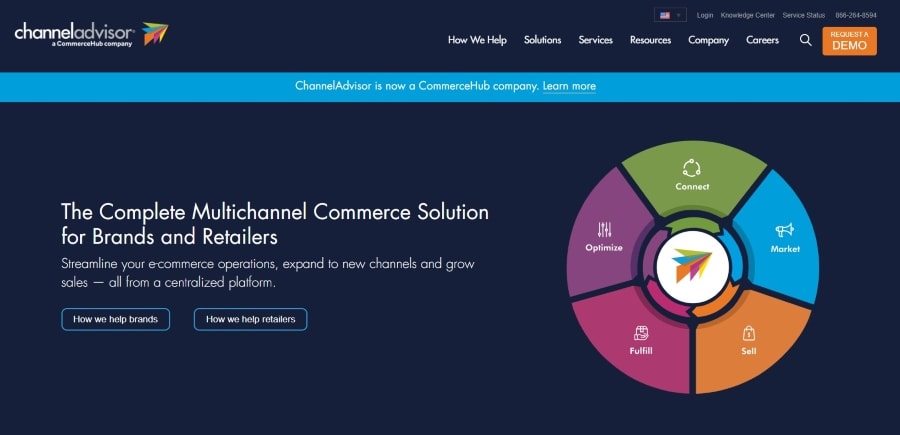
ChannelAdvisor is a comprehensive multichannel inventory management tool designed for e-commerce businesses. It enables sellers to efficiently manage product listings, automate order processing, and optimize their online sales across various marketplaces.
Key Features
- Multichannel listing and inventory synchronization.
- Advanced reporting and analytics for data-driven decisions.
- Seamless integration with major e-commerce platforms and marketplaces.
Pros:
- Robust reporting and analytics capabilities.
- Extensive integration options.
- Scalable for businesses of all sizes.
Cons:
- Complex for beginners.
- Pricing can be expensive for small businesses.
URL: ChannelAdvisor
Orderhive
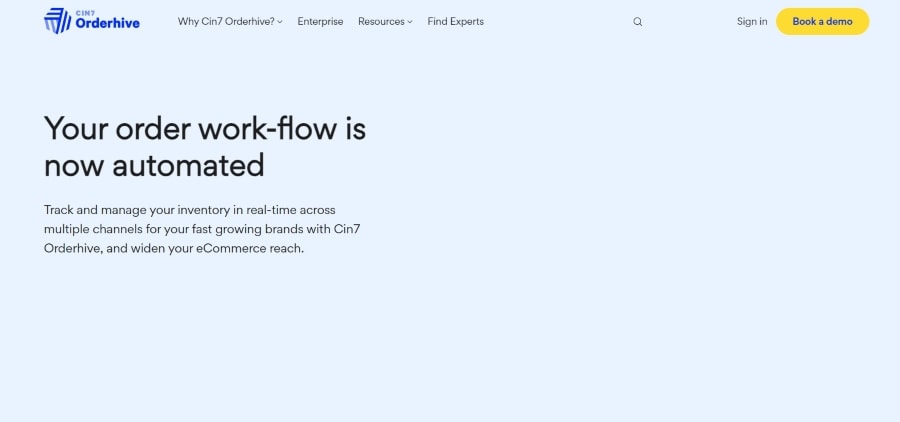
Orderhive is a user-friendly multichannel inventory management software designed to streamline order fulfillment and inventory tracking for e-commerce businesses. It offers features like order management, inventory tracking, and shipping management.
Key Features
- Inventory tracking across multiple channels and warehouses.
- Order processing automation.
- Real-time analytics and reporting.
Pros:
- Intuitive interface.
- Affordable pricing for small businesses.
- Integration with popular e-commerce platforms.
Cons:
- Limited advanced features compared to some competitors.
- May not scale well for very large businesses.
URL: Orderhive
Sellbrite
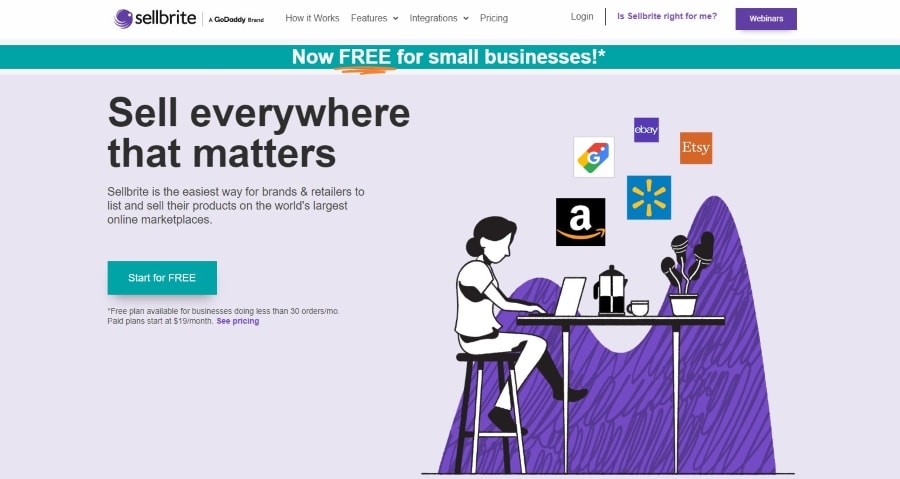
Sellbrite is a multichannel inventory management tool focused on simplifying the listing and order management process for e-commerce sellers. It provides a centralized platform for managing inventory and orders across multiple channels.
Key Features
- Multichannel listing and inventory synchronization.
- Order routing and fulfillment automation.
- Real-time inventory tracking.
Pros:
- User-friendly interface.
- Seamless integration with popular marketplaces.
- Affordable pricing options.
Cons:
- May lack advanced features required by larger enterprises.
- Reporting capabilities are basic compared to some competitors.
URL: Sellbrite
SellerCloud
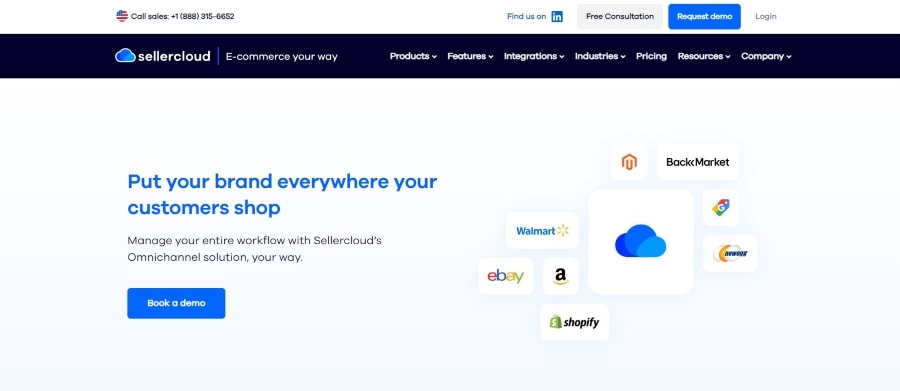
SellerCloud is a robust multichannel inventory management and order fulfillment solution designed for mid-sized to large e-commerce businesses. It offers a wide range of features to streamline operations and optimize sales across various channels.
Key Features
- Multichannel inventory management and synchronization.
- Order processing automation and shipping management.
- Advanced reporting and analytics.
Pros:
- Comprehensive feature set suitable for larger businesses.
- Scalable and customizable.
- Strong customer support.
Cons:
- Complexity may be overwhelming for small businesses.
- Higher pricing compared to some competitors.
URL: SellerCloud
Zoho Inventory
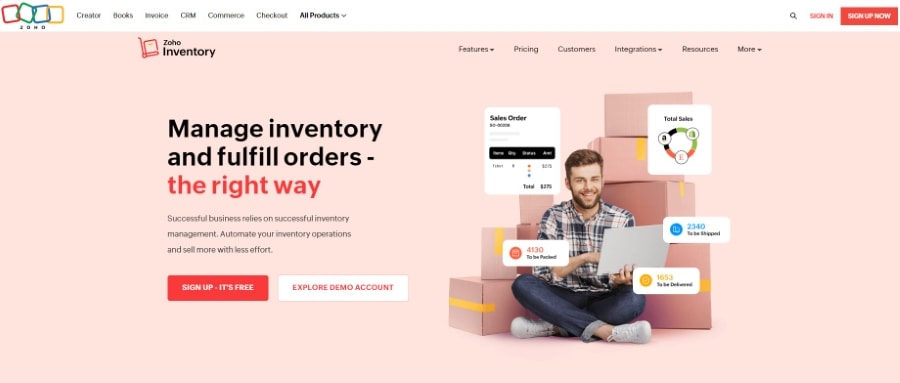
Zoho Inventory is a versatile inventory management tool that also offers multichannel capabilities. It’s part of the Zoho suite of business applications and is designed to help businesses of all sizes manage their inventory and sales across multiple channels.
Key Features
- Inventory tracking and order management across channels.
- Integration with popular e-commerce platforms and marketplaces.
- Reporting and analytics tools.
Pros:
- Affordable pricing with a free plan available.
- Seamless integration with other Zoho apps.
- Suitable for small to medium-sized businesses.
Cons:
- May lack some advanced features required by larger enterprises.
- Support may not be as robust as some competitors.
URL: Zoho Inventory
Comparison of Multichannel Inventory Management Tools
| Feature | ChannelAdvisor | Orderhive | Sellbrite | SellerCloud | Zoho Inventory |
| Multichannel Inventory Management | Yes | Yes | Yes | Yes | Yes |
| Order Processing Automation | Yes | Yes | Yes | Yes | Yes |
| Real-time Inventory Tracking | Yes | Yes | Yes | Yes | Yes |
| Advanced Reporting and Analytics | Yes | Yes | Basic | Yes | Yes |
| Integration with E-commerce Platforms and Marketplaces | Yes | Yes | Yes | Yes | Yes |
| User-friendly Interface | No (Complex) | Yes | Yes | No (Complex) | Yes |
| Scalable for Larger Enterprises | Yes | Limited | Limited | Yes | Limited |
| Customer Support | Good | Decent | Decent | Strong | Average |
E-commerce Platforms
In addition to dedicated inventory management software, many e-commerce platforms offer built-in inventory management features. For example:
-
Shopify: Shopify provides a robust inventory management system that allows businesses to track stock levels, set low-stock alerts, and manage product variants efficiently. It integrates seamlessly with various apps and tools to enhance multichannel selling capabilities.
-
WooCommerce: As a popular WordPress plugin, WooCommerce offers a range of extensions and plugins that enable effective multichannel inventory management. It allows businesses to sync their inventory across different sales channels while providing real-time stock updates.
-
Magento: Magento is a feature-rich e-commerce platform that includes built-in inventory management functionality. It enables businesses to manage their products, track stock levels, and fulfill orders from multiple channels seamlessly.
Pros:
-
Seamless integration with the respective e-commerce platform.
-
Eliminates the need for additional software or tools.
-
Simplifies the process of managing inventory alongside other e-commerce operations.
Cons:
-
Limited advanced features compared to dedicated inventory management software.
-
May require additional plugins or extensions for specific functionalities.
Barcode Scanning Systems
Barcode scanning systems play a crucial role in accurate tracking of stock movements and updating inventory records in real-time. These systems use barcode scanners or mobile devices equipped with scanning capabilities to scan barcodes on products, enabling businesses to automate data entry processes and reduce human errors.
Pros:
-
Increases efficiency by speeding up data entry processes.
-
Reduces manual labor required for tracking stock movements.
-
Enhances accuracy in updating inventory records.
Cons:
-
Initial setup costs can be expensive.
-
Requires training for employees to operate the scanning devices effectively.
Cloud-Based Solutions
Cloud-based solutions have become increasingly popular for multichannel inventory management.
These solutions allow businesses to access their inventory data remotely from anywhere at any time, providing flexibility and convenience.
Real-time Visibility and Synchronization
Real-time visibility and synchronization are crucial aspects of multichannel inventory management.
They allow businesses to monitor stock levels across all sales channels simultaneously and ensure that changes in one channel are immediately reflected in others, avoiding discrepancies or overselling situations.
Accurate visibility enables effective demand planning, preventing stockouts or excess inventory.
By having real-time access to information about stock levels, businesses can make informed decisions about when to reorder products, ensuring that they have enough inventory on hand to meet customer demand without tying up excessive capital in excess stock.
With real-time synchronization, businesses can seamlessly fulfill orders across different channels.
When a customer places an order on one platform, the inventory is automatically updated across all platforms in real time. This reduces the risk of delayed shipments and improves overall customer satisfaction.
Benefits of Real-time Visibility:
-
Effective Demand Planning: Accurate visibility allows businesses to analyze historical sales data and trends across multiple channels. This helps them forecast future demand more accurately and plan their inventory accordingly. By understanding which products are selling well and which ones are not, businesses can optimize their inventory levels for maximum profitability.
-
Prevention of Stockouts: Real-time visibility enables businesses to identify low stock levels promptly. With this information at hand, they can proactively restock popular items before they run out, preventing stockouts and potential lost sales opportunities.
-
Avoidance of Excess Inventory: On the flip side, real-time visibility also helps prevent excess inventory by identifying slow-moving or stagnant products early on. Businesses can take action by offering promotions or discounts to clear out these items before they become deadstock.
-
Improved Customer Satisfaction: Real-time visibility allows businesses to provide accurate information about product availability to customers across all channels. This reduces the risk of customers placing orders for out-of-stock items and ensures a seamless shopping experience.
Benefits of Real-time Synchronization:
-
Seamless Order Fulfillment: Real-time synchronization ensures that orders placed on one channel are immediately reflected in other channels. This eliminates the need for manual updates or reconciliations, reducing the risk of errors and delays in order fulfillment.
-
Reduced Overselling: By synchronizing inventory levels across all sales channels, businesses can avoid overselling situations. When an item is sold on one platform, the stock level is automatically adjusted across all platforms, preventing customers from placing orders for products that are no longer available.
-
Efficient Inventory Management: Real-time synchronization allows businesses to have a centralized view of their inventory across multiple channels. This simplifies inventory management tasks such as tracking stock movements, conducting audits, and generating reports.
-
Expanded Market Reach: With real-time synchronization, businesses can easily expand their market reach by selling on multiple platforms or marketplaces. They can manage their inventory efficiently and fulfill orders seamlessly regardless of the platform used by customers.
Customer-Centric Approach and Improved Customer Service
Multichannel inventory management is all about putting the customer first. By implementing efficient inventory management systems, businesses can offer a consistent and satisfying experience to their customers across all channels.
Let’s dive into how this approach improves customer service and satisfaction.
Timely Order Processing
One of the key benefits of multichannel inventory management is the ability to process orders in a timely manner.
With real-time visibility into stock availability, businesses can ensure that they have the products ready for shipment when an order comes in. This eliminates delays and ensures that customers receive their orders promptly.
Accurate Stock Availability Information
Nothing frustrates customers more than placing an order only to find out later that the product is out of stock. Multichannel inventory management allows businesses to keep track of their stock levels accurately across various channels.
This means that when a customer places an order, they can be confident that the product is available and will be shipped without any issues.
Prompt Shipping
Efficient inventory management also enables businesses to ship orders quickly and efficiently. By streamlining their fulfillment processes, companies can minimize delays and get products out for delivery as soon as possible.
This not only improves customer satisfaction but also helps build trust with customers, making them more likely to return for future purchases.
Reduced Likelihood of Canceled Orders
Stock unavailability often leads to canceled orders, which can be frustrating for both customers and businesses alike. With multichannel inventory management, companies can stay on top of their stock levels at all times.
This reduces the likelihood of canceled orders due to unavailability, ensuring that customers receive their desired products without any hiccups.
Multiple Fulfillment Options
In addition to timely order processing and prompt shipping, multichannel inventory management allows businesses to offer multiple fulfillment options to their customers.
For example, they can provide options such as ship-from-store or in-store pickup. This flexibility enhances convenience for customers, allowing them to choose the most convenient method of receiving their purchases.
Enhanced Customer Satisfaction
By focusing on efficient inventory management and implementing a customer-centric approach, businesses can significantly improve overall customer satisfaction.
When customers have a positive experience with a brand, they are more likely to become loyal customers and recommend the company to others. Satisfied customers also tend to leave positive reviews and feedback, which can further enhance the reputation of the business.
Improved Brand Image
Efficient multichannel inventory management not only benefits individual customers but also helps build a strong brand image for companies.
When businesses consistently deliver on their promises by providing accurate stock availability information, prompt shipping, and multiple fulfillment options, they establish themselves as reliable and trustworthy brands in the eyes of consumers.
This can lead to increased customer loyalty and attract new customers who are drawn to the brand’s reputation for excellent customer service.
Warehouse Management Capability and Challenges
Effective multichannel inventory management requires robust warehouse management capabilities. This means having the ability to efficiently handle and process large volumes of stock across multiple channels.
Optimizing warehouse layout is crucial in ensuring smooth operations and maximizing productivity.
By organizing products strategically, it becomes easier for employees to locate items quickly, reducing the time spent searching for specific SKUs. Implementing efficient picking strategies further improves order fulfillment speed, allowing customers to receive their purchases in a timely manner.
Managing different SKUs, packaging requirements, and shipping methods can be challenging in a multichannel environment. With various channels comes the need to adapt to different customer preferences and fulfillment centers’ specifications.
Each channel may have unique packaging requirements or utilize different parcel carriers for shipping. It’s essential for businesses to have the flexibility and capability to manage these variables effectively.
Inventory accuracy is crucial in multichannel inventory management as well. Maintaining accurate stock levels helps prevent mispicks, misplaced items, or shipping errors that can lead to dissatisfied customers and increased costs for businesses.
Having real-time visibility into inventory levels allows businesses to make informed decisions about restocking and avoid stockouts or overstock situations.
To overcome these challenges, businesses need robust warehouse management systems that provide comprehensive tools for managing inventory across multiple channels. These systems should offer features such as:
Warehouse Operations Management
Efficiently managing warehouse operations involves optimizing space utilization, streamlining receiving processes, implementing effective put-away strategies, and ensuring accurate picking and packing procedures.
-
Optimizing Space Utilization: Making the most of available space by organizing products based on their frequency of movement or size.
-
Streamlining Receiving Processes: Setting up streamlined processes for receiving incoming shipments promptly.
-
Effective Put-Away Strategies: Strategically placing received items in designated storage locations.
-
Accurate Picking and Packing Procedures: Ensuring correct item selection during order fulfillment while maintaining high accuracy rates.
Inventory Management
Managing inventory effectively is crucial for multichannel operations to prevent stockouts, overstocks, and fulfillment delays.
-
Real-Time Inventory Visibility: Having access to accurate and up-to-date information on stock levels across all channels.
-
Demand Forecasting: Utilizing historical data and market trends to forecast future demand accurately.
-
Reorder Point Optimization: Setting optimal reorder points to ensure timely replenishment of inventory.
-
Batch and Expiry Date Tracking: Managing products with expiration dates or batch numbers to prevent wastage or selling expired items.
Order Fulfillment Automation
Automating order fulfillment processes can significantly improve efficiency and reduce errors in a multichannel environment.
-
Order Routing: Automatically directing orders to the most appropriate fulfillment center based on factors such as proximity or stock availability.
-
Pick-Pack Automation: Utilizing technologies like barcode scanning and automated picking systems to streamline the picking and packing process.
-
Shipping Integration: Integrating with various parcel carriers’ systems for seamless shipping label generation and tracking.
The Importance of Multichannel Inventory Management
In today’s competitive business landscape, multichannel inventory management plays a crucial role in ensuring operational efficiency and customer satisfaction. By effectively managing inventory across multiple channels, businesses can streamline their operations, improve order fulfillment processes, and enhance the overall customer experience.
Real-time visibility and synchronization are key factors in multichannel inventory management. With accurate and up-to-date information on stock levels, businesses can prevent overselling or stockouts, leading to improved order accuracy and reduced fulfillment errors.
A customer-centric approach is vital in meeting the demands of modern consumers who expect seamless shopping experiences across various channels. By implementing effective strategies for multichannel inventory management, businesses can optimize their supply chain operations and offer improved customer service.
To achieve success in multichannel retailing, it is essential for businesses to invest in top software and tools specifically designed for inventory management across multiple channels.
These solutions provide comprehensive features such as centralized inventory control, order tracking, and integration with various sales channels.
By leveraging these technologies, businesses can efficiently manage their inventory while minimizing manual efforts and reducing the risk of errors.
In conclusion, multichannel inventory management is an integral aspect of modern retail operations. It enables businesses to meet customer expectations by ensuring product availability across all sales channels while optimizing operational efficiency.
By adopting effective strategies and utilizing appropriate software solutions, businesses can gain a competitive edge in today’s dynamic marketplace.
FAQs
How does multichannel inventory management benefit my business?
Multichannel inventory management offers several benefits to your business. It allows you to have real-time visibility into your stock levels across different sales channels, preventing overselling or stockouts. This leads to improved order accuracy and reduced fulfillment errors. It helps you provide a seamless shopping experience for customers by ensuring product availability across all channels.
What are some effective strategies for multichannel inventory management?
Some effective strategies for multichannel inventory management include centralizing your inventory control, utilizing automation tools, implementing demand forecasting techniques, and integrating your sales channels with your inventory management system. These strategies help streamline operations, improve efficiency, and enhance customer satisfaction.
How can software solutions assist in multichannel inventory management?
Software solutions specifically designed for multichannel inventory management provide comprehensive features such as centralized inventory control, order tracking, and integration with various sales channels. These tools automate manual processes, reduce the risk of errors, and provide real-time insights into stock levels and order fulfillment.
What challenges are associated with multichannel inventory management?
Multichannel inventory management comes with certain challenges such as maintaining accurate stock levels across multiple channels, coordinating logistics and fulfillment processes effectively, managing returns and exchanges efficiently, and ensuring seamless integration between different sales channels and the inventory management system. However, these challenges can be overcome by adopting appropriate strategies and utilizing advanced software solutions.
How does multichannel inventory management contribute to improved customer service?
Multichannel inventory management enables businesses to offer improved customer service by ensuring product availability across all sales channels. Customers can easily find the products they need without encountering stockouts or delays in delivery. Accurate order fulfillment leads to higher customer satisfaction levels and builds trust in your brand.

